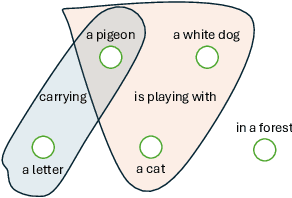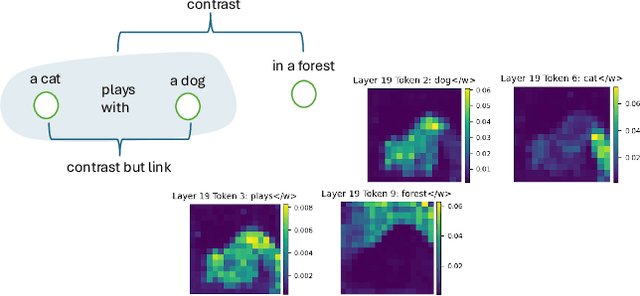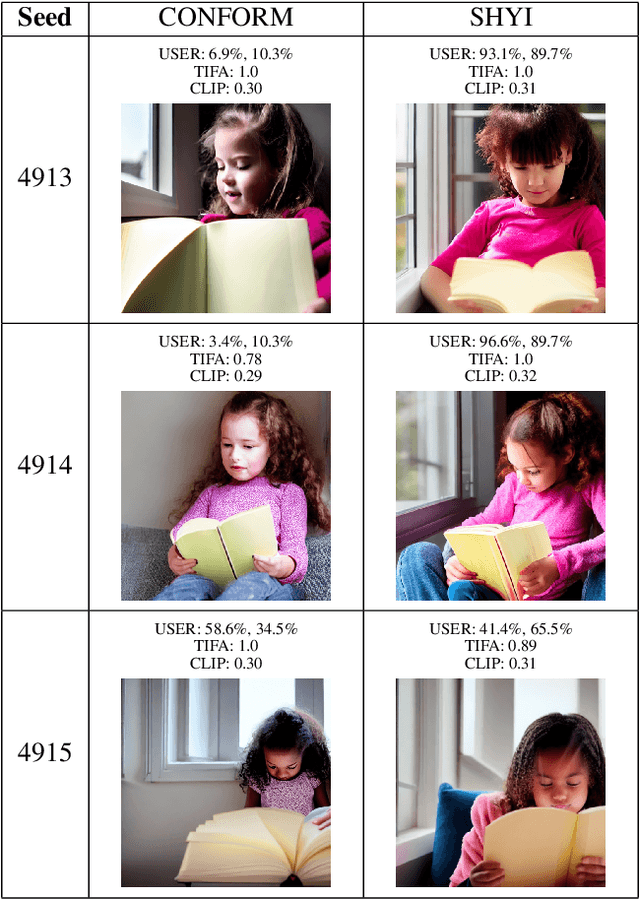Thomas Hofmann
ETH Zurich
Optimal Control Meets Flow Matching: A Principled Route to Multi-Subject Fidelity
Oct 02, 2025Abstract:Text-to-image (T2I) models excel on single-entity prompts but struggle with multi-subject descriptions, often showing attribute leakage, identity entanglement, and subject omissions. We introduce the first theoretical framework with a principled, optimizable objective for steering sampling dynamics toward multi-subject fidelity. Viewing flow matching (FM) through stochastic optimal control (SOC), we formulate subject disentanglement as control over a trained FM sampler. This yields two architecture-agnostic algorithms: (i) a training-free test-time controller that perturbs the base velocity with a single-pass update, and (ii) Adjoint Matching, a lightweight fine-tuning rule that regresses a control network to a backward adjoint signal while preserving base-model capabilities. The same formulation unifies prior attention heuristics, extends to diffusion models via a flow-diffusion correspondence, and provides the first fine-tuning route explicitly designed for multi-subject fidelity. Empirically, on Stable Diffusion 3.5, FLUX, and Stable Diffusion XL, both algorithms consistently improve multi-subject alignment while maintaining base-model style. Test-time control runs efficiently on commodity GPUs, and fine-tuned controllers trained on limited prompts generalize to unseen ones. We further highlight FOCUS (Flow Optimal Control for Unentangled Subjects), which achieves state-of-the-art multi-subject fidelity across models.
Structured Sparse Transition Matrices to Enable State Tracking in State-Space Models
Sep 26, 2025Abstract:Modern state-space models (SSMs) often utilize transition matrices which enable efficient computation but pose restrictions on the model's expressivity, as measured in terms of the ability to emulate finite-state automata (FSA). While unstructured transition matrices are optimal in terms of expressivity, they come at a prohibitively high compute and memory cost even for moderate state sizes. We propose a structured sparse parametrization of transition matrices in SSMs that enables FSA state tracking with optimal state size and depth, while keeping the computational cost of the recurrence comparable to that of diagonal SSMs. Our method, PD-SSM, parametrizes the transition matrix as the product of a column one-hot matrix ($P$) and a complex-valued diagonal matrix ($D$). Consequently, the computational cost of parallel scans scales linearly with the state size. Theoretically, the model is BIBO-stable and can emulate any $N$-state FSA with one layer of dimension $N$ and a linear readout of size $N \times N$, significantly improving on all current structured SSM guarantees. Experimentally, the model significantly outperforms a wide collection of modern SSM variants on various FSA state tracking tasks. On multiclass time-series classification, the performance is comparable to that of neural controlled differential equations, a paradigm explicitly built for time-series analysis. Finally, we integrate PD-SSM into a hybrid Transformer-SSM architecture and demonstrate that the model can effectively track the states of a complex FSA in which transitions are encoded as a set of variable-length English sentences. The code is available at https://github.com/IBM/expressive-sparse-state-space-model
Scalable Non-Equivariant 3D Molecule Generation via Rotational Alignment
Jun 11, 2025Abstract:Equivariant diffusion models have achieved impressive performance in 3D molecule generation. These models incorporate Euclidean symmetries of 3D molecules by utilizing an SE(3)-equivariant denoising network. However, specialized equivariant architectures limit the scalability and efficiency of diffusion models. In this paper, we propose an approach that relaxes such equivariance constraints. Specifically, our approach learns a sample-dependent SO(3) transformation for each molecule to construct an aligned latent space. A non-equivariant diffusion model is then trained over the aligned representations. Experimental results demonstrate that our approach performs significantly better than previously reported non-equivariant models. It yields sample quality comparable to state-of-the-art equivariant diffusion models and offers improved training and sampling efficiency. Our code is available at https://github.com/skeletondyh/RADM
JEDI: The Force of Jensen-Shannon Divergence in Disentangling Diffusion Models
May 25, 2025Abstract:We introduce JEDI, a test-time adaptation method that enhances subject separation and compositional alignment in diffusion models without requiring retraining or external supervision. JEDI operates by minimizing semantic entanglement in attention maps using a novel Jensen-Shannon divergence based objective. To improve efficiency, we leverage adversarial optimization, reducing the number of updating steps required. JEDI is model-agnostic and applicable to architectures such as Stable Diffusion 1.5 and 3.5, consistently improving prompt alignment and disentanglement in complex scenes. Additionally, JEDI provides a lightweight, CLIP-free disentanglement score derived from internal attention distributions, offering a principled benchmark for compositional alignment under test-time conditions. We will publicly release the implementation of our method.
Generalized Interpolating Discrete Diffusion
Mar 06, 2025Abstract:While state-of-the-art language models achieve impressive results through next-token prediction, they have inherent limitations such as the inability to revise already generated tokens. This has prompted exploration of alternative approaches such as discrete diffusion. However, masked diffusion, which has emerged as a popular choice due to its simplicity and effectiveness, reintroduces this inability to revise words. To overcome this, we generalize masked diffusion and derive the theoretical backbone of a family of general interpolating discrete diffusion (GIDD) processes offering greater flexibility in the design of the noising processes. Leveraging a novel diffusion ELBO, we achieve compute-matched state-of-the-art performance in diffusion language modeling. Exploiting GIDD's flexibility, we explore a hybrid approach combining masking and uniform noise, leading to improved sample quality and unlocking the ability for the model to correct its own mistakes, an area where autoregressive models notoriously have struggled. Our code and models are open-source: https://github.com/dvruette/gidd/
IC-Portrait: In-Context Matching for View-Consistent Personalized Portrait
Jan 31, 2025Abstract:Existing diffusion models show great potential for identity-preserving generation. However, personalized portrait generation remains challenging due to the diversity in user profiles, including variations in appearance and lighting conditions. To address these challenges, we propose IC-Portrait, a novel framework designed to accurately encode individual identities for personalized portrait generation. Our key insight is that pre-trained diffusion models are fast learners (e.g.,100 ~ 200 steps) for in-context dense correspondence matching, which motivates the two major designs of our IC-Portrait framework. Specifically, we reformulate portrait generation into two sub-tasks: 1) Lighting-Aware Stitching: we find that masking a high proportion of the input image, e.g., 80%, yields a highly effective self-supervisory representation learning of reference image lighting. 2) View-Consistent Adaptation: we leverage a synthetic view-consistent profile dataset to learn the in-context correspondence. The reference profile can then be warped into arbitrary poses for strong spatial-aligned view conditioning. Coupling these two designs by simply concatenating latents to form ControlNet-like supervision and modeling, enables us to significantly enhance the identity preservation fidelity and stability. Extensive evaluations demonstrate that IC-Portrait consistently outperforms existing state-of-the-art methods both quantitatively and qualitatively, with particularly notable improvements in visual qualities. Furthermore, IC-Portrait even demonstrates 3D-aware relighting capabilities.
SHYI: Action Support for Contrastive Learning in High-Fidelity Text-to-Image Generation
Jan 15, 2025



Abstract:In this project, we address the issue of infidelity in text-to-image generation, particularly for actions involving multiple objects. For this we build on top of the CONFORM framework which uses Contrastive Learning to improve the accuracy of the generated image for multiple objects. However the depiction of actions which involves multiple different object has still large room for improvement. To improve, we employ semantically hypergraphic contrastive adjacency learning, a comprehension of enhanced contrastive structure and "contrast but link" technique. We further amend Stable Diffusion's understanding of actions by InteractDiffusion. As evaluation metrics we use image-text similarity CLIP and TIFA. In addition, we conducted a user study. Our method shows promising results even with verbs that Stable Diffusion understands mediocrely. We then provide future directions by analyzing the results. Our codebase can be found on polybox under the link: https://polybox.ethz.ch/index.php/s/dJm3SWyRohUrFxn
On the Expressiveness and Length Generalization of Selective State-Space Models on Regular Languages
Dec 26, 2024



Abstract:Selective state-space models (SSMs) are an emerging alternative to the Transformer, offering the unique advantage of parallel training and sequential inference. Although these models have shown promising performance on a variety of tasks, their formal expressiveness and length generalization properties remain underexplored. In this work, we provide insight into the workings of selective SSMs by analyzing their expressiveness and length generalization performance on regular language tasks, i.e., finite-state automaton (FSA) emulation. We address certain limitations of modern SSM-based architectures by introducing the Selective Dense State-Space Model (SD-SSM), the first selective SSM that exhibits perfect length generalization on a set of various regular language tasks using a single layer. It utilizes a dictionary of dense transition matrices, a softmax selection mechanism that creates a convex combination of dictionary matrices at each time step, and a readout consisting of layer normalization followed by a linear map. We then proceed to evaluate variants of diagonal selective SSMs by considering their empirical performance on commutative and non-commutative automata. We explain the experimental results with theoretical considerations. Our code is available at https://github.com/IBM/selective-dense-state-space-model.
UIP2P: Unsupervised Instruction-based Image Editing via Cycle Edit Consistency
Dec 19, 2024



Abstract:We propose an unsupervised model for instruction-based image editing that eliminates the need for ground-truth edited images during training. Existing supervised methods depend on datasets containing triplets of input image, edited image, and edit instruction. These are generated by either existing editing methods or human-annotations, which introduce biases and limit their generalization ability. Our method addresses these challenges by introducing a novel editing mechanism called Cycle Edit Consistency (CEC), which applies forward and backward edits in one training step and enforces consistency in image and attention spaces. This allows us to bypass the need for ground-truth edited images and unlock training for the first time on datasets comprising either real image-caption pairs or image-caption-edit triplets. We empirically show that our unsupervised technique performs better across a broader range of edits with high fidelity and precision. By eliminating the need for pre-existing datasets of triplets, reducing biases associated with supervised methods, and proposing CEC, our work represents a significant advancement in unblocking scaling of instruction-based image editing.
LoRACLR: Contrastive Adaptation for Customization of Diffusion Models
Dec 12, 2024Abstract:Recent advances in text-to-image customization have enabled high-fidelity, context-rich generation of personalized images, allowing specific concepts to appear in a variety of scenarios. However, current methods struggle with combining multiple personalized models, often leading to attribute entanglement or requiring separate training to preserve concept distinctiveness. We present LoRACLR, a novel approach for multi-concept image generation that merges multiple LoRA models, each fine-tuned for a distinct concept, into a single, unified model without additional individual fine-tuning. LoRACLR uses a contrastive objective to align and merge the weight spaces of these models, ensuring compatibility while minimizing interference. By enforcing distinct yet cohesive representations for each concept, LoRACLR enables efficient, scalable model composition for high-quality, multi-concept image synthesis. Our results highlight the effectiveness of LoRACLR in accurately merging multiple concepts, advancing the capabilities of personalized image generation.
 Add to Chrome
Add to Chrome Add to Firefox
Add to Firefox Add to Edge
Add to Edge